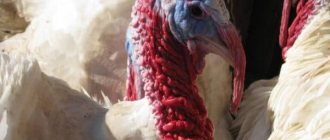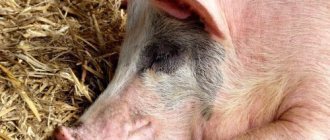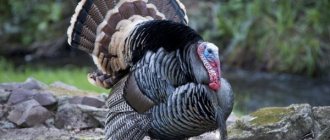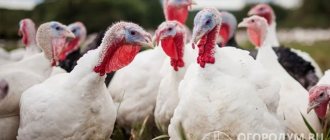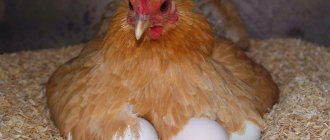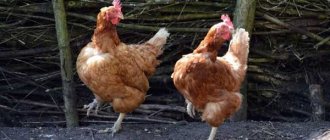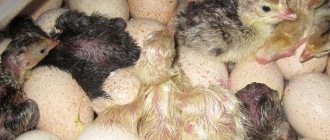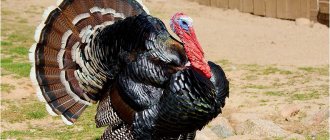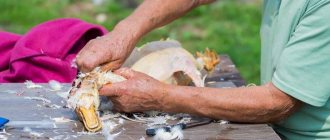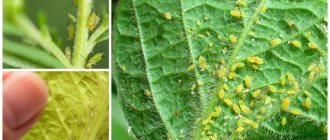Home » Articles about turkeys » How to pluck a turkey?
The first rule describing how to pluck a turkey correctly: carry out the procedure carefully and quickly. It is best to slaughter and process the bird before the molting period, otherwise removing the feathers will severely damage the skin on the carcass.
There are 4 main ways to pluck turkeys:
- dry;
- with scalding;
- using an iron;
- using special nozzles or devices.
When understanding how to pluck a turkey, it is important to remember: this is a very difficult job, so it is difficult to do it without a developed skill. It requires strict adherence to instructions and a willingness to work hard.
Safety of meat products
There are several ways to store turkeys before eating or selling:
- cellar or glacier;
- vacuum packaging;
- freezing containers.
After the bird has been gutted, it is not recommended to consume meat products immediately. It needs some time to ripen: at this moment fermentation occurs. Under the influence of natural enzymes, the structure of the protein changes, it becomes more acceptable for consumption and is better absorbed by the body.
After the cooling phase has passed, the muscle fibers become stiff. After 24-48 hours (it all depends on the age characteristics of the bird), the muscles relax, and the meat product is considered ready for consumption. Young animals ripen earlier - in 12 hours.
How to remove a feather from a carcass
There are two methods for removing feather cover: dry and wet. In the first option, plucking must be done immediately after the bird is slaughtered. This will ensure longer storage of meat.
Turkey studding
Flight and tail feathers are easier to remove when scalded: here it is important to know about the temperature of the water and the length of time the carcass is kept in it. The recommended temperature of the liquid should not be more than 60 degrees to avoid scalding the skin. The maximum amount of time for which a carcass can be placed in water is one minute. Then it must be removed and the feathers removed. If you allow it to cool, the process will slow down significantly.
To maintain the integrity of the skin, the feather is pulled out in the direction of growth. Removing fluff and small feathers should not pose any particular problems. Then the series of stumps and scorching of the lower fluff begins. After removing the feather cover, you need to clean the oral cavity from any remaining blood, wash the limbs and wipe them dry, and then begin the process of removing the internal organs.
Removal of internal organs
How long does a turkey grow and why do turkeys not gain weight?
The main task of those who keep this poultry is to ensure that the turkey gains the maximum possible weight
Therefore, it is important to know how long a turkey grows, so as not to feed it in vain if it is intended for slaughter. It should be said that most breeds gain maximum weight by the age of 5 months
So, at the age of more than 6 months, there is no point in keeping such a bird any longer. On the contrary, turkey meat may become tougher.
Chicken feathers in chickens - how to get rid of them
However, before reaching this age, some individuals stop gaining weight and even lose weight. There may be several reasons for this. Improper living conditions or improper feeding. You may also lose your appetite for natural reasons. For example, males lose weight during estrus. During this period, it is better to feed them with carrots and cottage cheese so that they do not lose weight. And for turkeys during the egg-laying period, add yeast and products containing vitamin B to the feed.
What are the special devices?
If there is a large volume of birds on the farm, then it will be very difficult to work with each carcass yourself, so there are special devices that can help you with this. Most farmers use a screwdriver or drill, or whatever they can find at home. But for such tools you will need to buy special attachments, with the help of which you can very quickly and easily strip the carcass of all feathers. In fact, this cleaning procedure will take no more than two to three minutes. The most important thing to pay attention to is that it is best to do this outdoors, but if you do it indoors, then it will be completely covered in feathers, which will then have to be removed.
Afterwards it will be necessary to check and sort all the received material. In addition, today there is a special machine that removes the top cover. Its size will depend on what breed of turkeys you have and how long they are. The principle of its operation is very easy. The finished carcass is placed in a special drum, which has already heated up to a certain temperature. When it starts to spin, special fingers that are inside it will gradually remove all the feathers. Turkey is best slaughtered at the age of seven to eight months. Turkeys are usually slaughtered at the age of two years, this is due to the fact that, unlike the Turkey, the male can retain his mating ability longer.
Plucking and gutting a turkey is one of the most difficult and arduous jobs. They require a lot of attention and concentration. A turkey, like any bird, must be plucked quickly and thoroughly. Of course, all this must be done before the molting period, otherwise the carcass can become very spoiled. That is why experts recommend carefully monitoring this period.
Turkey slaughter
Keep in mind that slaughtering a bird is a rather responsible procedure and should be taken seriously. Even if you do it the old fashioned way, using an axe, try to at least bring the slaughter area into compliance with minimum sanitary standards. Remember that in the summer flies, carriers of various infections, instantly flock to the blood, and a lot of parasites live in the soil.
Prepare everything you need in advance: dry, clean rags, enough water, thoroughly wash your tools (knife, axe). If you choose an axe, you don’t need to do it directly on the surface of the old deck. Place some kind of tabletop on it, after wiping it.
It is interesting to know how much a turkey chick and an adult turkey weigh.
Slaughter
If you decide to resort to the internal slaughter method, it must be done in the following sequence:
- Open the turkey's beak and use a sharp knife to sharply cut the vessels located on the left above the tongue.
- The blade is pulled out slightly and a thrust is made just as sharply, but a little lower and in the center. The hand with the knife should move from bottom to top, its target is the cerebellum.
- The carcass is hung by the legs to drain the blood.
- A completely bled carcass can be plucked.
Plucking
It is best to pluck a bird immediately after slaughter. In private households and small farms, the procedure is carried out manually. In order to properly pluck the carcass and remove all the flight feathers, it is doused with hot water.
Find out more about how to pluck a turkey at home.
The water temperature should not exceed 65 °C, and the carcass should remain in the water for no more than a minute. Immediately after removal from the water, plucking begins. This must be done quickly so that the pores do not have time to close, in which case the flight feathers are very difficult to remove.
When all the feathers are removed, it is necessary to give the carcass a normal appearance:
- remove blood from the throat and mouth;
- rinse extremities thoroughly;
- use a dry cloth to remove moisture from the carcass, and you can singe;
- singeing at home is carried out over a gas stove, slowly and smoothly passing the carcass over the fire;
- After removing the remaining feathers with fire, you can begin gutting.
Important! It is believed that it is better to pluck the turkey as soon as the blood has drained, and it is better to let the turkey cool.
Gutting
The poultry gutting procedure is carried out as follows:
- The carcass is placed on its back on a stable horizontal surface (table).
- With one hand they hold the carcass by the sternum, with the other they stick a knife into the center of the belly, just below the chest. Moving the knife down, cut the peritoneum.
- The intestines are removed from the slot along with the cloaca.
- The stomach, liver, crop and heart are removed separately.
In the event that all the offal (together with the emptied and washed stomach) and the neck are placed back into the womb, the evisceration is considered incomplete. Such meat should not be stored in the refrigerator for more than 48 hours.
Complete evisceration involves removing the neck down to the second vertebra, while the skin around the neck is also removed, the paws are chopped down to the knees, and the kidneys and lungs remain in the belly of the carcass.
Find out the benefits of turkey meat, turkey liver, turkey eggs.
Description of the procedure
Feathers are trimmed after the feather cover is renewed - the result is maintained until the next molt. You will need 2 people to do the job - one to hold the turkey, securing the legs and holding it in place, and the other to do the trimming. If the bird actively resists, it can cause serious wounds to a person with its claws or beak. A bag placed over the turkey’s head will save the situation (it can be replaced with an opaque fabric). Limitation of vision is disorienting. In most cases, such a measure is not necessary - the operation is painless and does not take much time.
After the turkey is secured, the wing is opened like a fan. Feathers are cut to 2/3 of the length using sharp scissors or pruning shears. As for the technique, several options are possible.
- You can trim the secondary flight feathers - they are located on the side of the forearm. This “haircut” does not deteriorate the appearance of the birds. The downside is that this may not prevent flights.
- Experienced poultry farmers recommend immediately shortening the main flight feathers located on the hand. It is believed that it is enough to treat 1 side - the balance will be disrupted and flights will become impossible. Judging by the reviews, the effectiveness of this method is questionable, but it’s worth a try. Much depends on the weight of the bird - it will be difficult for heavy birds to get into the air and maintain balance; for light breeds, it is quite possible that they will be able to fly short distances and fly up onto the roof or tree branches.
- Trimming two wings at once is considered the most effective. A “haircut” will most likely prevent flights. But this method also does not guarantee a 100% result - many note that the bird still takes off, only it flaps its wings more often. This mainly applies to light breeds.
- Another option involves completely shortening the main feathers on one wing. On the other side they are trimmed one at a time. The tail, which serves as a rudder during flight, is thinned out in the same way. This method can bring positive results.
- The next option does not involve shortening at all. The cut is made along the shaft of the feather, removing the fan from one side. This creates holes that make it impossible to fly. The advantage of this method is the preservation of length - the hen does not lose the opportunity to scoop the eggs under herself. In addition, the appearance suffers minimally.
- Another method is called chess. On the first flight feather, the fan is cut off on one side, the second is shortened by half the length. This is repeated with all the main flight feathers.
- The next method involves partial shortening. The first 4-5 flight feathers are left long, the rest are cut off by 2/3 of the length. With the wing closed, such a hole is invisible, and the appearance of the birds does not suffer. Nothing prevents the hen from taking care of the clutch. The effectiveness is questionable. Many note that individuals belonging to light breeds continue to fly.
Slaughtering turkeys at home: photo and video review
Surely, any novice farmer would like to learn about how to properly slaughter poultry, namely turkeys. These large birds are loved by many for the high quality of meat and its large quantity. Read below on how to slaughter turkeys at home, as well as other useful tips.
In order to properly slaughter turkeys, the main condition must be met: to free the stomach and intestines of the selected bird or group of birds from food debris. For this purpose, feeding the wards is stopped 12 hours before the slaughter procedure. This condition is the key to good quality of the resulting meat, which is better stored and has a higher taste. If the meat will not be stored, but will go straight to the table, it is recommended to use the simplest slaughter method - separating the head of the bird.
With this method, the bird's jugular vein is cut, located 2.5 cm below the ear near the facial and carotid arteries. The external method can be called more “dirty”, but it is very popular in villages and small farms.
Involves cutting the blood vessels above the turkey's tongue, at the back of the roof of the mouth. The jugular and pontine veins are located there. Then, with a sharp object, usually the same one used to cut large blood vessels, a single targeted blow is made to the head. With both the external and internal methods, after the death of the bird, its wings are spread, and the carcass is hung so that the throat is closer to the ground. With such a suspension, the carcass will be easy to pluck, and turkeys are plucked immediately, before they cool down, and turkeys a little later.
For a good poultry farmer, useful tips will not be superfluous, since small tricks not only improve the quality of the finished meat, but also save the farmer’s time
It is most important to follow these rules after slaughtering a bird:
- do not freeze meat in a hurry (the nutritional value and structure of muscle fibers deteriorate);
- store the product in the cellar or in the refrigerator for no longer than a week in its raw form;
- treat carcasses with saline solution for longer storage (400 grams of salt per 1 liter of water).
Regardless of the method of slaughter, the bird carcass is hung upside down so that the blood drains completely. Then they proceed directly to processing the poultry. The more carefully and accurately the slaughter is carried out in compliance with all standards, the longer the meat will be stored at home and the higher its nutritional characteristics will be.
There are two types of plucking: dry and wet. The first involves “fresh” plucking, immediately after slaughter. The wet method means scalding the carcass with boiling water, this makes it easier to remove the hard tail and flight feathers. To avoid damaging the skin, feathers should be plucked in the direction of their growth, just like down. To remove feather stumps, use the method of burning with dry fuel or gas.
Gutting begins with an incision in the abdominal cavity of the bird, through which the entrails are removed, as well as the oviduct (in females) and the crop. The process can be carried out completely, with the removal of all internal organs, or it can be half - when only the intestines, cloaca and goiter are removed. Ready turkey meat is divided according to the degree of maturity of the bird into young and adult. Carcasses are not frozen immediately, but are pre-cooled at a temperature of 2°C to 4°C, so the meat freezes more evenly and does not spoil for a long time.
Obviously, the process of slaughtering poultry will be successful if the farmer follows all the rules and recommendations. And the detailed video instructions posted on the website will answer all additional questions related not only to the slaughter process, but also to plucking and gutting the bird.
The material provides detailed instructions for slaughtering, plucking, singeing and gutting poultry.
How to raise broiler turkeys and their characteristics
Turkey business: basics and aspects of activity
How to feed turkeys to gain weight?
Share information on social networks:
Need some advice?
You need to keep and feed turkeys for 7-8 months, 10-12 kg. clean meat. How we feed piglets. It's a lie that it's 3 months. 6 kg.
No, it's not a lie. The turkey weighed 11 kg for 5 months.
I am 5 months old and weighs only 5 kg.
I am 6 months old and weighs 20 kg.
My 3 and a half month old turkey and turkey were slaughtered yesterday, the weight is clean without the navel, kidneys, head and legs. The male has 11,700, the hen has 5,970. The slaughter was forced, they fell ill - the right side of the turkey’s chest was broken, and the turkey’s liver was damaged.
I haven't gained any weight either
- Expenses and income for laying hens
- Meat chicken diet
- Diet of productive geese
- Diet of breeding turkeys
- Guinea fowl diet
- Quail diet
- Diet of pheasants for meat
- Income from the sale of eggs
- Baby rabbit
- Farrowing sow
- Sheep lambing
- Calving cow
- Foaling mare
- Lambing of a goat
What are the methods for slaughtering turkeys?
There are various methods for slaughtering turkeys. The most commonly used option is external slaughter, which is simpler and easier to implement.
External slaughter
This is the most common method of slaughter. It is divided into left-sided and opposite two-sided. This method involves making a small incision in the turkey to open the jugular vein.
Left hand:
- Grab the turkey by the beak.
- Cut through the skin, veins and arteries. The length of the cut should be 2-2.5 cm for a large turkey and 1-1.5 cm for a baby.
Double sided:
- Pierce the skin under the ear and open all the veins, moving the blade to the right.
- On the other side you should have a hole of up to 1.5 cm.
Below is a video of a turkey being slaughtered and gutted:
Internal slaughter
This is the cleanest method of turkey slaughter among all existing ones. It is also the most delicate. In another way it is also called “into the cleft”:
- Stun the turkey by hitting it in the head.
- Insert the knife as deep into the throat as possible, and then cut the vessels in the back palate. You need to cut on the left above the tongue. Select this location as this is where the jugular and pontine veins connect.
- Stab the turkey into the cerebellum. Aim for the lower right side of the head through the palatal opening. This injection helps relax the turkey's muscles. After this, the blood comes out better and the bird is easier to pluck.
- Bleed the carcass. To do this, hang it by its paws, spreading its wings. Place a basin under the turkey to allow the blood to drain there.
- After this, plug the cut with a tampon so as not to stain the carcass with remaining drops of blood.
- After slaughter, the bird must be plucked.
How to gut a turkey?
Prepare a knife with a thin blade to make it easy to cut the ligaments. They cut open the bird's belly and then take out the internal organs: stomach, heart and liver.
Instructions for gutting a carcass:
If the gallbladder is damaged such that its entire contents spill onto the carcass, rinse the bird thoroughly in salt water. This will eliminate all germs and eliminate any unpleasant odors that may appear.
From the entrails, leave the liver, heart, and stomach. The rest is not suitable for food. Cut the stomach lengthwise and clean it under running water, removing the inner membrane. Rinse the carcass inside and out to remove any remaining blood. If you notice “stumps” that remain after the initial plucking, remove them with tweezers.
cut off the limbs at the knee joint
make an incision along the entire neck
we make an incision in the abdominal cavity and take out all the insides
cut out the internal organs along with the cloaca
if there are “stumps” left after plucking, remove them with tweezers
Full section
If you decide to use this method, cut off the cervical spine to the second vertebral joint. Then chop off the bird’s limbs at the joints and remove all the internal organs.
Partial section
The neck must remain intact, the internal organs are removed, washed, and then put back into the carcass. You don’t have to throw away the heart, stomach and liver; they can be useful for giblet gravy and other dishes using these organs. It is recommended to discard other organs; they are not suitable for consumption.
How to pluck a duck with an electric nozzle
The method is suitable if many ducks are slaughtered at the same time: plucking with a nozzle significantly speeds up the process.
You will need a hammer drill, grinder or drill, a special attachment for the selected tool with corrugated rubber elements of different directions.
How to process
- Turn on the instrument and bring the duck to it. The device is carefully secured.
- They start cutting. This is easy to do with kitchen poultry shears. The incision must be made along one side of the sternum, moving from the belly to the neck.
Then they start cooking the poultry meat.
How to score
Getting a quality product without losing a single gram of beneficial properties is the farmer’s main task. Turkeys are slaughtered before molting to avoid the appearance of a large number of feather stumps on the skin. This will make plucking and carving the turkey easier and faster.
Before slaughter:
- Do not feed birds - food residues in the esophagus, crop and intestines will lead to difficulties in cutting and contamination of the meat;
- turkeys should be kept in a dark room;
- It is necessary to supply water to the birds to thoroughly clean their intestines of feces.
Depending on the purpose of selling the product, there are 2 slaughter methods:
- Internal, when carcasses are prepared for sale. Promotes better storage of meat.
- The external method is more often used in households if the turkey is being slaughtered for immediate processing.
Internal method
Experienced farmers determine how many turkeys need to be raised for slaughter, based on the breed, quality of feed, and housing conditions. Turkeys raised for sale as whole carcasses are slaughtered using the internal method, “splitting”: the jugular and pontine veins of the bird are quickly cut, ensuring maximum blood flow.
To do this you need:
- Immobilize the bird.
- Open your beak as much as possible.
- Using scissors with very sharp tips, cut the connection of veins on the left side of the throat above the tongue.
- With a quick blow slightly lower from bottom to top on the right, pierce the cerebellum of the bird.
- Hang the carcass upside down over a blood collection container, spread the wings. This position will help the blood flow out of the carcass quickly.
The weight of the poultry determines how long it is necessary to keep the carcass suspended
It is important not to allow the turkey to cool down completely as this will make it difficult to pluck the turkey.
External method
Processing and using turkey meat directly after slaughter allows the use of an external method - more “sloppy”, but less labor-intensive:
- The turkey's legs are tied and placed in a bag.
- Through the hole made, the head and part of the neck are pulled out.
- Using a very sharp knife, the jugular vein is sharply cut from the outside: on the right, 2.5 cm below the ear opening.
- The bird is hung upside down with a container to collect blood. Pluck after complete drainage of blood from the carcass, preventing complete solidification.
Removing fluff with an iron
This method is very often used to remove all the cover from a domestic idea, and not from a wild one. It is advisable to use an iron that you no longer use and that has heating modes. To do this you will need:
- pump (which is used to inflate a mattress or balls);
- strong rope;
- products made from natural and pure fabric;
- shallow container with cold water;
- and, of course, an iron.
after you are sure that you have everything, you need to place the idea in the socket of the pump itself in the free space between the neck and the skin itself. Then you can start pumping air, but do it slowly and adjust the fullness of the space so that the skin does not burst. You can pump air until all the feathers rise up, but if this does not happen, you need to repeat everything again, perhaps you have positioned the pump incorrectly. The most important thing in this plucking method is that the skin does not burst.
after you have made sure that all the feathers have risen up, you can pull out the bell, and to prevent air from escaping, tie the bird’s throat with a rope, tightly and firmly, but so that later you can untie all the knots. Take a piece of cloth and wet it very well in water, cover the carcass with a rag and apply a hot iron. The temperature of the iron should be at 2-3 positions, but if you understand that the power is not enough, then increase it, the main thing is not to burn the idea. Instead of fabric, you can use gauze, but then it must be folded in half.
It's not difficult to pluck a turkey
Tips from farmers: It is better to use an iron that also has a steam function. When you “iron” the carcass, you can steam it, but no more than eight seconds. This will make it easier and easier to remove and remove the cover. Plucking a turkey is not a difficult task. In the video you can find information regarding plucking Turkey at home.
Turkeys before slaughter
The main value of turkey meat is its dietary properties. It has excellent taste and low fat content. More than 1/2 of the carcass is high-quality meat with a high protein content and only about 1/4 is fat, most of which is under the skin, that is, it can be easily removed. Therefore, turkey meat is in great demand; turkeys are bred both for personal consumption and for commercial purposes.
Find out how highbred turkeys grow: converter, grade maker, big 6, Canadian, bronze broad-breasted, white broad-breasted, bronze 708, Uzbek fawn.
How long do they grow?
With proper feeding and care, the bird quickly gains weight, and some males can grow up to 20 kg, females can gain half of this figure.
Poultry that has gained weight over 12 kg is suitable for slaughter. Most turkeys grow to these figures by the 33-35th week. Many broilers reach this weight by 17-25 weeks.
The second indicator is age. It is believed that many turkey breeds stop gaining weight after 6-9 months. That is, you need to focus on these deadlines. After this, the meat does not lose its dietary qualities. Even three-year-old turkeys are sent to slaughter; by this age they are of no interest as producers, and their processed meat is quite edible.
Did you know? America is considered the birthplace of turkeys. In 1519, this bird came to Spain, and it was called that
—
Spanish chicken, in the mid-20s of the 16th century, all of Europe was already familiar with these birds. By this time, they received another name - Turkish chickens.
How much do they eat?
In 16 weeks, a male turkey eats 32 kg of feed. During this time, the female needs to feed half the male’s norm. In more detail, the list of nutrition required for turkeys for the first 4 months of life looks like this:
- wheat - 10 kg;
- bran - 1.8-1.9 kg;
- greens - 5.7 kg;
- reverse - 300-350 ml;
- cottage cheese - 150 g;
- eggs, bone meal, salt, chalk and shells in small quantities.
After 16 weeks, the birds are force-fed dumplings of the following composition:
- corn flour - 4 parts;
- oatmeal - 3 parts;
- wheat bran - 5 parts;
- barley flour - 5 parts;
- milk, water or whey - 3 parts;
- salt and yeast.
After 1.5-2 weeks of such a diet, turkeys can be sent to slaughter, but more often feeding is extended to 2-3 weeks, because such a diet provides a daily increase of 100 g of live weight.
Learn how to keep turkeys at home in winter.
Plucking method after scalding
Today, there are more than four ways to pluck domestic turkeys at home. Most farmers prefer this method because of the ease of the process. The main feature of scalding is that the carcass must be scalded in hot water before being stripped of its feathers. Turkeys are very soft meat, so they need to be handled carefully.
There is no need to keep the carcass at this temperature for a long time - one minute, and then take it out and immediately pluck it. If you do this after the carcass has cooled, it will be very difficult to pluck it. In order to keep the turkey skin in good condition, the covering must be pulled out in the direction of their growth. Small hairs and fluff can be removed very easily, and after that all the “stumps” must be carefully removed, and then small feathers.
After all the procedures, to be absolutely sure that there are no hairs left, you need to rinse the carcass over the fire. This is done very simply; you can use a gas stove. We turn on the gas and smoothly process the carcass over the fire, but the main thing is not to bring it too close, as you can burn it and then the meat can spoil, and if the carcasses are being prepared for sale, they immediately automatically lose their presentation.
How to gut a turkey
Sequencing:
- Cut through the belly of the bird using a knife.
- Remove and remove the intestines and cloaca.
- The cloaca must also be removed.
- Remove organs that can be eaten (heart, crop, liver, stomach).
Incubation of turkey eggs: choice of device, temperature and humidity when hatching
A carcass in which the head is separated at the level of the second vertebra is considered completely gutted. In this case, the lungs and kidneys remain in the cavity of the carcass.
A turkey that is not completely gutted will still have the heart, gizzard, and liver. All these organs are first removed and washed under clean water, then placed back into the cavity of the bird.
The skin from the neck is not removed. The disadvantage of the product is its short shelf life, the maximum is 4 days (if the carcass is stored in the refrigerator).
When does turkey slaughter occur?
For slaughter, it is best to take a bird whose body weight is at least 12 kg. Most turkeys reach this size by 8-9 months. Broiler representatives reach a similar weight already at 18-25 weeks. You can slaughter older individuals, but in this case the meat will not be as tender.
Experienced farmers believe that at 2-3 years a turkey reaches its maximum age suitable for slaughter. Despite the low juiciness of the meat product, it can be used as minced meat or for preparing first courses.
In older birds, the meat already becomes tough, as a result of which it loses its presentation. An old turkey is identified by the keratinized surface of its beak, elongated “spurs,” and also by highly visible bones. It is recommended to slaughter the turkey before the first feather change, so that you do not have to fuss with feathers for a long time. When they have decided how long the turkeys will grow before slaughter, then they begin preparatory activities.
Preparation
The last meal of the bird should be 12-15 hours before the actual slaughter, so that the turkey’s body does not become covered with spots. As a result of this, the esophagus is completely freed from food. The birds are placed in a room with virtually no lighting. The farmer must ensure there is enough water and also give the turkey a solution of Glauber's salt. Due to this, the intestines will empty faster.
There are several kilograms of grain per head, so cleansing the digestive system takes a long time. In the absence of cleaning procedures, the carcass gets dirty during gutting. In addition, if you slaughter a bird with dirty intestines and do not cut it for a long time, the product will be poisoned by feces.
It is recommended to add wheat bran or rye flour to the menu before slaughter to improve the quality of future turkey meat. Turkeys must be slaughtered at home before molting. Because when changing feathers, it is almost impossible to pluck the bird. In addition, unsightly stumps and dark spots remain on the carcass. For this reason, the cost of meat on the market is significantly reduced.
Enclosures must be thoroughly cleaned of excrement and food residues before placing turkeys. Equipment and tools that will be used during slaughter must be treated with disinfectants. Otherwise, the dirt located on them will get inside the meat, causing the turkey to become contaminated. The carcass must be completely bled to prevent bacteria from spreading through the blood vessels.
Fattening
To quickly gain live weight, experienced farmers recommend buying cross-breed turkeys. The greatest demand among poultry farmers is Big-8, Hybrid Converter, as well as But-8 and Grade Maker. It is best to feed birds with balanced feed, the variety of which is selected depending on the life cycle of the birds.
Young animals gain body weight suitable for slaughter already at 4 months, with an average weight of 14-16 kg. The slaughter yield at this age is 80-85%, since poultry farmers get up to 12-14 kg per head. During this time, males eat approximately 32 kg of combined food, and females - 16 kg.
An approximate list of foods that birds eat for 16 weeks:
- wheat and wheat bran – 10 and 1.8-2 kg, respectively;
- skim milk – 300-350 ml;
- fresh green mass – 5.7-6 kg;
- cottage cheese with low fat content – 150 g;
- bone meal, salt, chalk and other food additives in moderation.
Representatives of the meat sector are kept for up to 6-8 months, since at this age it is possible to obtain a higher slaughter yield from them. The birds are fed both combination mixtures and standard food. The traditional menu includes root vegetables, as well as mineral supplements and proteins.
Expert opinion Mikhailova Alla Sergeevna Poultry farmer with 25 years of experience. Breeding and caring for poultry.
To reduce the cost of purchasing food, it is recommended to put birds out to pasture.
After 4 months, birds are mainly fed lumps of dough, which are made from the following products:
- corn, oat and barley flour - 4, 3 and 5 parts, respectively;
- bran – 5 parts;
- filtered water, milk or whey – 3 parts;
- table salt and yeast.
This diet lasts for 14 days, after which the turkey is ready for slaughter. However, farmers often feed their livestock in this way for 2-3 weeks. This is due to the fact that every day the bird gains 100 grams.
Choosing a breed for growing
Before breeding turkeys, farmers choose the most suitable breed for themselves. The vast majority of turkey breeds are considered ready for slaughter when they reach six months of age. However, there are many fast-growing breeds that are best slaughtered at an earlier age.
Large representatives of fast-growing breeds include Big-6, broad-breasted white and others. Broiler breeds are much more profitable to raise for slaughter.
It was mentioned above that at a certain period in the life of turkeys, their growth rate begins to decrease significantly. This moment is optimal for slaughter, but what happens if you miss it?
Firstly, after this period it becomes unprofitable to keep the bird. She gains further body weight from fat. At the same time, he eats quite a lot of food.
Secondly, the older the turkey, the lower the quality of its meat. To a greater extent, the decrease in quality relates to taste characteristics. Turkey meat has dietary properties at any age.
If a farmer maintains a flock for continuous breeding, then in it he allocates a parent group for procreation. Representatives of this group live two to three years before slaughter, until their reproductive capabilities begin to fade.
The meat of turkeys of this group is practically no different from the meat of young animals. It is also suitable for sale and consumption.
Preparing for plucking
The main operation before plucking is proper slaughter. Incorrect actions at this stage lead to wing fractures and hematomas. With such “battle wounds,” the presentation of the carcass cannot be preserved even by removing the feathers as carefully as possible.
Experienced poultry farmers advise using metal cones for slaughtering chickens. The bird is placed on a daily fast ration (water is left) in an isolated cage. After 24 hours, they are hit on the head with an ax head and placed in the device. The neck and head are released through the lower narrow opening. The rest of the body is located inside the funnel with folded wings. The carotid artery is cut 10 mm from the auricle. The knife blade is held slightly tilted downwards. Then place the container under the cone and wait until the blood has completely drained.
Slaughtering chicken in a cone
Dead birds are not immediately frozen. She needs to stay in a cool place for 24 hours, otherwise the meat will become tough and lose its taste. It is advisable to pluck immediately after bleeding. It is almost impossible to remove feathers from a numb body without torn skin without first steaming it.
Proper preparation of turkeys
To prevent the bird from becoming covered with various stains after slaughter, it must not be allowed to eat for about twelve to fifteen hours before slaughter. This measure helps free the digestive system from the feed mass.
To prevent the bird from worrying, it is better to place it in a dark room, there should be enough water, you can give a solution of Glauber's salt. Such measures will help you empty your bowels faster.
Turkeys should be slaughtered at home before the molting process begins. If the bird has changed its plumage, it will not be successfully plucked. Dark spots will remain on the skin, which reduce the cost of meat when sold.
The pens in which the selected livestock are placed are thoroughly cleaned of feed and droppings. All equipment used for slaughter must undergo mandatory disinfection. Contaminated instruments are also sources of infection.
One turkey eats several pounds of grain, so it may take some time to completely clean out the intestines. If you do not carry out such procedures, then during gutting you can stain the meat.
When slaughtering, you need to remember that the carcass must be completely and quickly bled! Thanks to this approach, bacteria will not have a chance to start spreading through the circulatory system.
How to determine whether a bird is ready for slaughter
Determining the correct timing is a very important parameter for any poultry farmer. Domestic turkeys can be put under the knife as soon as they reach a weight of 12 kg. The average age of birds at this moment reaches 240-300 days.
It is worth paying attention to the fact that meat breeds require slightly less time to grow. Broiler turkeys can be slaughtered from day 120. Poultry farmers should know that birds that are too young or too old are not suitable for meat production. The meat obtained from the first type of birds is too little, and from the second the quality of meat is not very high.
recommended articles:
- How to slaughter and process a chicken?
- How to cut a turkey at home?
Fattening turkeys
Many breeders consider the optimal period for slaughtering livestock that has reached the age of 2-3 years. This category of turkeys produces less juicy products, but is perfect for first courses or stuffing. At this age, birds must be slaughtered, otherwise the meat products become tough and practically lose their value. It is necessary to score before the change of feather cover begins, otherwise thorough plucking will not work.
Slaughtering turkeys at home, features
Turkey is a large bird, the quality of its slaughter determines the taste of the meat and its benefits to humans. The main problem with domestic poultry slaughter is its size.
During preparatory activities, you must not scare the birdIt is difficult for one person to catch, immobilize and kill a feathered resident of the yard without outside help. It is necessary to have someone hold the turkey while the farmer tries to slaughter it properly.
Important! Prepare for the procedure in advance by carefully studying the methods of plucking poultry, following the advice of experienced poultry farmers and acting in accordance with your own experience. Reddened meat, which is the result of inattention to the process, will not be accepted for sale; it will be dangerous to eat it
Reddened meat, which is the result of inattention to the process, will not be accepted for sale; it will be dangerous to eat it.
Useful tips
In order to pluck a duck raised on a home farm efficiently and quickly, you need to know the rules of the procedure. It is worth listening to the advice of experienced poultry farmers. These recommendations will help make the process of removing feathers and subsequent butchering of the duck easier:
- It is better to pluck birds outdoors. This way there will be no unpleasant smell or large amounts of garbage in the house.
- Before starting the procedure, you need to completely drain the blood from the killed duck.
- You should pluck the bird confidently, with sharp movements, grabbing the feathers with your index finger and thumb.
- Before removing feathers and down, remove the skin from the paws.
- If the feather sits quite deep, then it is better to use tweezers or tweezers. This will prevent damage to the skin.
- Before butchering, wild birds are checked for the presence of shot in the carcass. A duck caught during a hunt is soaked for several hours.
- The gutted and cut up carcass is stored in the refrigerator or freezer. Sometimes farmers resort to salting, which increases the shelf life of meat.
Plucking and subsequent gutting of poultry or wild birds requires certain knowledge and skills. However, with clear instructions, even a beginner can handle the job. The main thing is to follow the rules and act confidently. And then plucking and cutting up a duck, goose or turkey will not be difficult.
Turkeys before slaughter
The main value of turkey meat is its dietary properties. It has excellent taste and low fat content. More than 1/2 of the carcass is high-quality meat with a high protein content and only about 1/4 is fat, most of which is under the skin, that is, it can be easily removed. Therefore, turkey meat is in great demand; turkeys are bred both for personal consumption and for commercial purposes.
How long do they grow?
With proper feeding and care, the bird quickly gains weight, and some males can grow up to 20 kg, females can gain half of this figure.
Poultry that has gained weight over 12 kg is suitable for slaughter. Most turkeys grow to these figures by the 33-35th week. Many broilers reach this weight by 17-25 weeks.
The second indicator is age. It is believed that many turkey breeds stop gaining weight after 6-9 months. That is, you need to focus on these deadlines. After this, the meat does not lose its dietary qualities. Even three-year-old turkeys are sent to slaughter; by this age they are of no interest as producers, and their processed meat is quite edible.
How much do they eat?
In 16 weeks, a male turkey eats 32 kg of feed. During this time, the female needs to feed half the male’s norm. In more detail, the list of nutrition required for turkeys for the first 4 months of life looks like this:
- wheat - 10 kg;
- bran - 1.8-1.9 kg;
- greens - 5.7 kg;
- reverse - 300-350 ml;
- cottage cheese - 150 g;
- eggs, bone meal, salt, chalk and shells in small quantities.
After 16 weeks, the birds are force-fed dumplings of the following composition:
- corn flour - 4 parts;
- oatmeal - 3 parts;
- wheat bran - 5 parts;
- barley flour - 5 parts;
- milk, water or whey - 3 parts;
- salt and yeast.
After 1.5-2 weeks of such a diet, turkeys can be sent to slaughter, but more often feeding is extended to 2-3 weeks, because such a diet provides a daily increase of 100 g of live weight.
Methods of slaughter
In small private farms, the most popular method of slaughtering birds is cutting off the head with an ax. But this method is only suitable for immediate meat processing. Such slaughter is usually carried out on the street, without observing sanitary standards, which is fraught with infection with various infectious diseases and parasites.
A carcass with an open wound lies in the air, sometimes on the ground. And in the summer, this method is generally dangerous due to the large number of insects.
If meat needs to be preserved for as long as possible without processing, for example, for sale, the closed method, slaughtering through the beak, is the most appropriate. The sooner the carcass is completely bled, the longer it will be stored.
Interior
Deep in the bird's palate are the jugular and pontine veins, which must be cut. A bird with this method of slaughter dies quite quickly from blood loss.
External
This method is not as clean as the previous one, however, it is more popular among farmers. Probably for the reason that it requires less qualifications than the internal method. The name of the method itself suggests that the blood vessels of the bird are opened from the outside of the carcass.
Video: turkey slaughter
Removing fluff with an iron
This method is very often used to remove all the cover from a domestic idea, and not from a wild one. It is advisable to use an iron that you no longer use and that has heating modes. To do this you will need:
- pump (which is used to inflate a mattress or balls);
- strong rope;
- products made from natural and pure fabric;
- shallow container with cold water;
- and, of course, an iron.
after you are sure that you have everything, you need to place the idea in the socket of the pump itself in the free space between the neck and the skin itself. Then you can start pumping air, but do it slowly and adjust the fullness of the space so that the skin does not burst. You can pump air until all the feathers rise up, but if this does not happen, you need to repeat everything again, perhaps you have positioned the pump incorrectly. The most important thing in this plucking method is that the skin does not burst.
It's not difficult to pluck a turkey
Tips from farmers: It is better to use an iron that also has a steam function. When you “iron” the carcass, you can steam it, but no more than eight seconds. This will make it easier and easier to remove and remove the cover. Plucking a turkey is not a difficult task. In the video you can find information regarding plucking Turkey at home.
Fattening
When breeding turkeys, heavy crosses are purchased to quickly obtain meat. The most popular among poultry farmers are BIG-6, BYuT-8, Hybrid Converter, and Grade Maker. Individuals are characterized by rapid growth and accelerated gain of muscle mass. Fattening is recommended to be done with combined feeds. At different periods of life, a certain version of the mixture is chosen.
Turkey poults are kept in brooders for 21 days, after which the livestock are transferred to a pen for bedding. They reach productive weight at the age of 4 months. The average body weight of turkey poults is 14-16 kg. Meat yield 85%. From each turkey you can get a carcass weighing 12-14 kg.
In 16 weeks, a male turkey eats 32 kg of feed. During this time, the female needs to feed half the male’s norm. In more detail, the list of nutrition required for turkeys for the first 4 months of life looks like this:
- wheat - 10 kg;
- bran - 1.8-1.9 kg;
- greens - 5.7 kg;
- reverse - 300-350 ml;
- cottage cheese - 150 g; eggs, bone meal, salt, chalk and shells in small quantities.
Turkeys of meat breeds are kept for up to 6-8 months. For fattening, not only combined mixtures are used, but also a traditional diet, which consists of vegetables, protein and mineral supplements. Some farmsteads, in order to reduce costs, keep their livestock on pastures.
After 16 weeks, the birds are force-fed dumplings of the following composition:
- corn flour - 4 parts;
- oatmeal - 3 parts;
- wheat bran - 5 parts;
- barley flour - 5 parts;
- milk, water or whey - 3 parts;
- salt and yeast.
After 1.5-2 weeks of such a diet, turkeys can be sent to slaughter, but more often feeding is extended to 2-3 weeks, because such a diet provides a daily increase of 100 g of live weight.
Announcements on NN.RU – House
Inexpensive professional repair of washing machines on the day of your call, free consultation over the phone. Sometimes breakage is possible.
Repair of washing machines . Diagnostics and visit are free for repairs within the city! > affordable repair prices from 300 rubles. >.
New absolutely serviceable 2 steam stations. in the store they are about 8 thousand. Exhibition samples. In boxes, complete sets. To those who. Price: 4,500 rub.
A technician will come to your home in all areas of the city, I will advise you over the phone on reasonable prices - compressor repair - refilling with freon, etc.
Turkey behavior disorder
For turkeys, aggression is a sane behavior, but it should not cross the boundaries of what is permitted. If a bird constantly pecks at other domestic birds, behaves too arrogantly, is rude, and purrs loudly, then its behavior needs to be adjusted.
Sometimes a turkey is too calm or apathetic - this is also a sign of behavioral disorder. Birds can even pretend to be dead by panting and barely moving. This is often how depression manifests itself.
It is important to carefully monitor how the herd behaves and promptly remove from it individuals who are experiencing various types of malaise. Noise helps to understand this
If birds constantly scream loudly or, conversely, are silent, you will have to sound the alarm.
